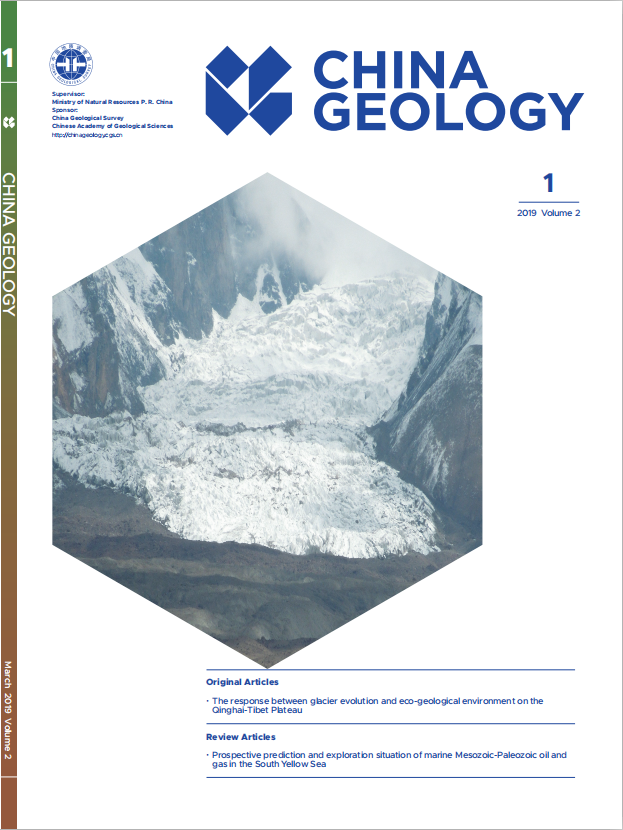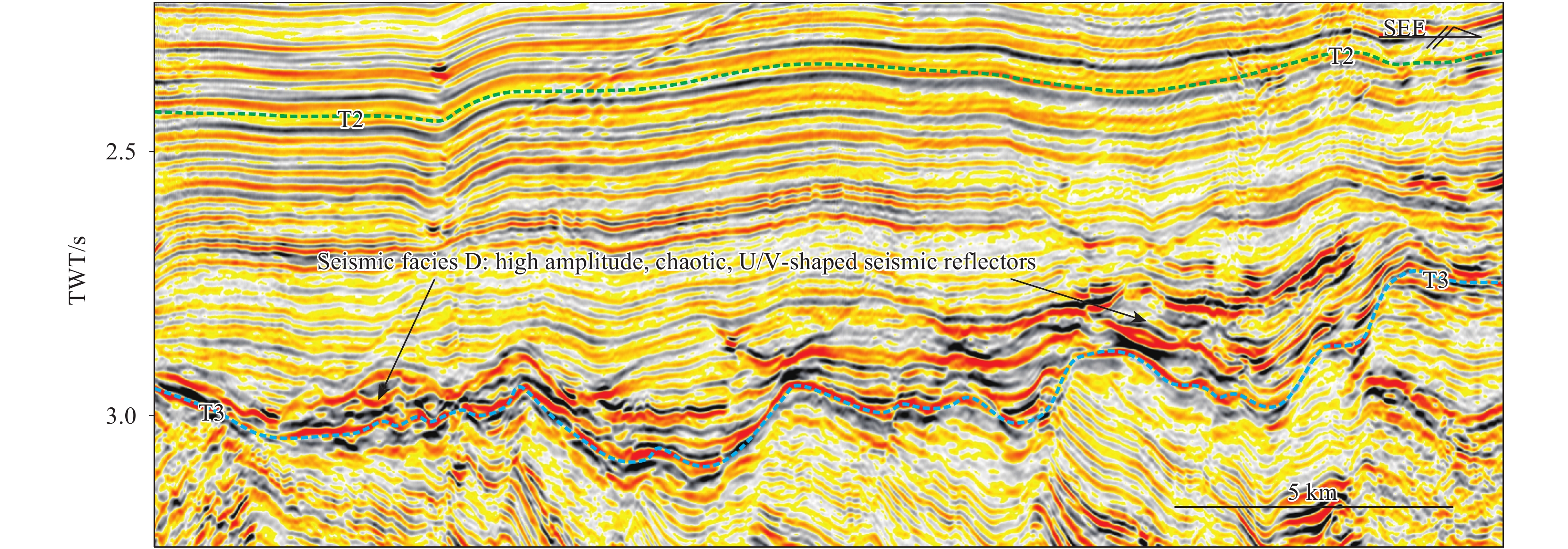| Citation: | Zhen-yu Lei, Li Zhang, Ming Su, Shuai-bing Luo, Xing Qian, Bo-da Zhang, 2019. Types, characteristics and implication for hydrocarbon exploration of the Middle Miocene deep-water sediments in Beikang Basin, southern South China Sea, China Geology, 2, 85-93. doi: 10.31035/cg2018094 |
Types, characteristics and implication for hydrocarbon exploration of the Middle Miocene deep-water sediments in Beikang Basin, southern South China Sea
-
Abstract
The internal seismic architectures of the Middle Miocene in Beikang Basin, southern South China Sea, were investigated and described using regional 2D seismic data from Guangzhou Marine Geology Survey. In particular, five typical seismic facies were identified based on an integrated analysis of the amplitude, continuity, contact relationship, and morphologies of seismic reflections. Bathyal-abyssal fine-grained sediments, deltaic front sandy bodies, turbidites, and small-scale turbidite channels were developed in the Middle Miocene according to the tectonic-sedimentary evolution of the sedimentary basins in the southern South China Sea. The findings of this study suggest that deltaic front sandy bodies and turbidites can be considered as the two major types of deep-water clastic reservoirs for the depression stage of Beikang Basin. A well-developed source-reservoir-cap assemblage was composed by deep rift-stage source rocks, deep-water clastic reservoirs of the Middle Miocene, and bathyal-abyssal deep-water fine-grained sediments after the Middle Miocene, implying a good potential for hydrocarbon exploration.
-
Keywords:
- Deep-water sediment /
- Middle Miocene /
- Beikang Basin /
- Southern South China Sea
-

-
References
[1] Clift P, Lee GH, Anh DN, Barckhausen U, Van LH, Zhen S. 2008. Seismic reflection evidence for a dangerous grounds miniplate: no extrusion origin for the South China Sea. Tectonics, 27, 1–16. [2] Cullen AB. 2010. Transverse segmentation of the Baram-Balabac basin, NW Borneo: refining the model of Borneo’s tectonic evolution. Petroleum Geoscience, 16, 3–29. doi: 10.1144/1354-079309-828 [3] Hassan MHA, Johnson HD, Allison PA, Abdullah WH. 2013. Sedimentology and stratigraphic development of the upper Nyalau Formation (Early Miocene), Sarawak, Malaysia: a mixed wave- and tide-influenced coastal system. Journal of Asian Earth Sciences, 76(1), 301–311. [4] Hutchison CS. 2004. Marginal basin evolution: the southern South China Sea. Marine and Petroleum Geology, 21, 1129–1148. doi: 10.1016/j.marpetgeo.2004.07.002 [5] Ismail MI, Eusoff AR, Mohamad AM. 1995. The geology of Sarawak deepwater and surrounding areas. Bulletin of the Geological Society of Malaysia, 37, 165–178. [6] Jin QH, Li TG. 2000. Regional geologic tectonics of the Nansha sea area. Marine Geology & Quaternary Geology, 20(1), 1–8. [7] Koŝa E. 2015. Sea-level changes, shoreline journeys, and the seismic stratigraphy of central Luconia, Miocene-present, offshore Sarawak, NW Borneo. Marine and Petroleum Geology, 59, 35–55. doi: 10.1016/j.marpetgeo.2014.07.005 [8] Liu BM, Jin QH. 1997. Hydrocarbon geological condition and distribution characteristic of Zengmu basin in southern South China Sea. Journal of Tropical Oceanography, 4, 18–25 (in Chinese with English abstract). [9] Liu ZH. 2005. Distribution of sedimentary basins and petroleum potential in southern South China Sea. Geotectonica et Metallogenia, 29(3), 410–417 (in Chinese with English abstract). [10] Madon M, Ly KC, Wong R. 2013. The structure and stratigraphy of deepwater Sarawak, Malaysia: implications for tectonic evolution. Journal of Asian Earth Sciences, 76, 312–333. doi: 10.1016/j.jseaes.2013.04.040 [11] Mat-Zin IC, Tucker ME. 1999. An alternative stratigraphic scheme for the Sarawak aasin. Journal of Asian Earth Sciences, 17(1), 215–232. [12] Mohammad AM, Wong RHF. 1995. Seismic sequence stratigraphy of the Tertiary sediments, offshore Sarawak deepwater area, Malaysia. Proceedings AAPG-GSM International Conference 1994-SE Asian Basins: Oil and gas for the 21st Century. Kuala Lumpur, Malaysia. [13] Qiu Yan. 1996. Analysis of sedimentary system of major hydrocarbon-bearing basins in southern South China Sea. Marine Geology, 2, 10–19 (in Chinese with English abstract). [14] Sun Z, Zhao ZX, Zhou D, Yang SK, Lin HM, Chen GH. 2011. The stratigraphy and the sequence architecture of the Basin in Nansha region. Earth Science Journal of China University of Geosciences, 36(5), 798–806 (in Chinese with English abstract). [15] Wang HB, Yao BC, Liang JQ, Liu ZH, Wang LL. 2001. Tectonic characteristics and division of the Beikang basin. Marine Geology & Quaternary Geology, 21(2), 49–54 (in Chinese with English abstract). [16] Wang LL, Wu NY, Zhou ZY, Chen Q. 2002. History of Cenozoic sedimentary evolution of the Beikang basin, southwestern South China Sea. Geology in China, 29(1), 96–102 (in Chinese with English abstract). [17] Warrlich G, Taberner C, Asyee W. 2010. The impact of postdepositional processes on reservoir properties: two case studies of Tertiary carbonate buildup gas fields in Southeast Asia (Malampaya and E11). In: Morgan W A, George A D, Harris P M, et al. (Eds.), Cenozoic Carbonate Systems of Australasia. SEPM, Special Publication 95, 99–127. [18] Wilson MEJ. 2005. Development of equatorial delta-front patch reefs during the Neogene, Borneo. Journal of Sediment Research, 75, 114–133. doi: 10.2110/jsr.2005.010 [19] Xie XJ, Zhang GC, Zhao ZG, Liu SX, Wang L, Lan L, Guo J, Wang Y, Song Shuang, Bi YK. 2015. Hydrocarbon geology, distribution and favorable exploration direction in Zengmu basin, South China Sea. China Offshore Oil and Gas, 27(1), 19–26 (in Chinese with English abstract). [20] Xie XN, Ren JY, Wang ZF, Li XS, Lei C. 2015. Different of tectonic evolution of continental marginal basins of South China Sea and relationship with SCS spreading. Earth Science Frontiers, 22(1), 77–88 (in Chinese with English abstract). [21] Yang MH, Zhang HH, Liao ZB, Luo XH, Yang G, Gong T. 2015. Petroleum systems of the major sedimentary basins in Nansha sea waters (South China Sea). Earth Science Frontiers, 22(3), 48–58 (in Chinese with English abstract). [22] Yao BC, Liu ZH. 2006. Sedimentary basins and petroleum resources in Nansha offshore area, South China Sea. China Offshore Oil and Gas, 18(3), 150–160 (in Chinese with English abstract). [23] Yao YJ, Yang CP, Li XJ, Ren JY, Jiang T, Tong DJ, Han B, Yin ZX, Xu QY. 2013. The seismic reflection characteristics and tectonic significance of the tectonic revolutionary surface of mid-Miocene (T3 seismic interface) in the southern South China Sea. Chinese Journal Of Geophysics, 56(4), 1274–1286. [24] Zampetti V, Schlager W, Van Konijnenburg JH, Everts AJ. 2004. 3D Seismic Characterization of Submarine Landslides on a Miocene Carbonate Platform (Luconia Province, Malaysia). Journal of Sedimentary Research, 74(6), 817–830. doi: 10.1306/040604740817 [25] Zeng QB, Chen GJ, Zhang GC, Ji M, Han YX, Guo S, Wang LY. 2015. The shelf-margin delta feature and its significance in Zhuhai Formation of deep-water area, Pearl River Mouth basin. Acta Sedimentologica Sinica, 33(3), 595–606. [26] Zhang GX, Yang Z, Zhang L, Yan W, Qiang KS. 2018. Study of over thrust nappe structure and its geodynamic mechanism along the southeastern margin of Nansha Trough. China Geology, 1(4), 459–465. doi: 10.31035/cg2018060 [27] Zhang HH, Liu P, Liao ZB, He QZ, Zhu XM. 2017. Oil and gas exploration potential in Beikang basin, Nansha sea area. China Petroleum Exploration, 22(3), 40–48 (in Chinese with English abstract). [28] Zhang L, Wang LL, Yi H. 2003. The formation and evolution of Beikang basin. China Offshore Oil and Gas (Geology), 17(4), 245–248 (in Chinese with English abstract). [29] Zhao CY, Song HB, Yang ZW, Song Y, Tian LH. 2014. Tectonic and thermal evolution modeling for the marginal basins of the southern South China Sea. Chinese Journal Of Geophysics, 57(5), 1543–1553. [30] Zhong GJ, Wu JM, Wang LL. 1995. Characteristics of strike-slip system and its relation to oil and gas in the south-west area of the South China Sea. Journal of Ocean University of Qingdao, 25(4), 495–502 (in Chinese with English abstract). -
Access History

-
Figure 1.
Location of Beikang Basin (study area) in the southern South China Sea (SCS).
-
Figure 2.
Sequence stratigraphic framework through the seismic profile in Beikang Basin, China (Fig. 1 for the location). T1−about 5.3 Ma, the boundary between Pliocene and Miocene; T2−about 10.5 Ma, the boundary between late Miocene and middle Miocene; T3−about 16 Ma, the boundary between middle Miocene and early Miocene; T4−about 32 Ma, the boundary between late Oligocene and early Oligocene; T4−about 40.4 Ma, the boundary between Oligocene and Eocene; Tg− about 58.7 Ma,the boundary between Paleocene and basement.
-
Figure 3.
Seismic facies A through the seismic profiles in Beikang Basin, China (Fig. 1 for the locations). a−SEE direction seismic line in southern Beikang Basin (close to Zengmu Basin), shows moderate amplitude continuous reflectors; b−NNE direction seismic line in southern Beikang Basin (close to Zengmu Basin), shows moderate amplitude continuous reflectors as well. T2−about 10.5 Ma, the boundary between late Miocene and middle Miocene; T3−about 16 Ma, the boundary between middle Miocene and early Miocene.
-
Figure 4.
Seismic facies B through the seismic profiles in the Beikang Basin, China (Fig. 1 for the locations). a−NNE direction seismic line shows seismic reflection structure is with wedge shape and is with gradually reducing thickness from south to north; b−SEE direction seismic line shows the seismic reflection structure with thin medium-high amplitude and better continuity can also be found. T2−about 10.5 Ma, the boundary between late Miocene and middle Miocene; T3−about 16 Ma, the boundary between middle Miocene and early Miocene.
-
Figure 5.
Seismic facies C through the seismic profiles in the Beikang Basin, China (Fig. 1 for the locations). a−NNE direction seismic line shows lenticular reflection characteristics (thick in the middle and thin at the both sides); b−SEE direction seismic line shows seismic reflection overlaps to the both sides; c−SEE direction seismic line shows that the distribution of seismic facies C is strongly controlled and limited by the local geographic and geomorphic conditions. T2−about 10.5 Ma, the boundary between late Miocene and middle Miocene; T3−about 16 Ma, the boundary between middle Miocene and early Miocene.
-
Figure 6.
Seismic facies D through the seismic profiles in the Beikang Basin, China (Fig. 1 for the locations). T2−about 10.5 Ma, the boundary between late Miocene and middle Miocene; T3−about 16 Ma, the boundary between middle Miocene and early Miocene.
-
Figure 7.
Seismic facies E through the seismic profiles in the Beikang Basin, China (Fig. 1 for the locations). a−NNE direction seismic line shows the seismic facies E with seismic reflection event of high amplitude, good continuity, and overlap to the both sides; b−SEE direction seismic line shows distribution of seismic facies E is controlled by the surrounding geographic and geomorphic conditions. T2−about 10.5 Ma, the boundary between late Miocene and middle Miocene; T3−about 16 Ma, the boundary between middle Miocene and early Miocene.





 DownLoad:
DownLoad:





